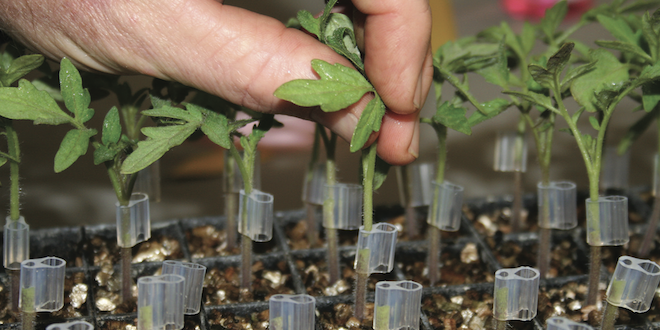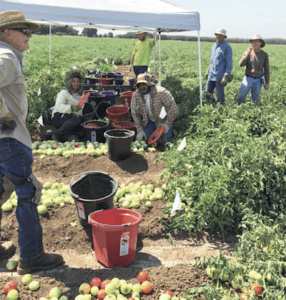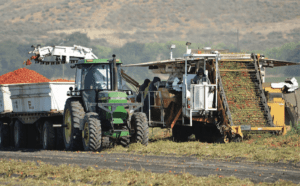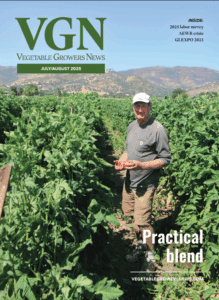
Jul 14, 2022Tomato grafting research shows potential, drawbacks
University of California researchers borrowed a page from the tree fruit industry handbook and looked at grafting tomato scion that produces desirable fruit onto hardy rootstocks.
Part of the impetus behind their field trials, which involved fresh-market and processing tomatoes, were soilborne pests that had overcome resistance in current cultivars, new soil borne pests and shrinking access to soil fumigants.
Although they found that some scion-rootstock combinations yielded significantly more than the non-grafted varieties in select years, the main challenge remains the high cost of grafting, said UC Extension farm advisor Brenna Aegerter, who is based in San Joaquin County.
“I think probably in the future a portion of the acreage will be grafted,” she said. “That’s my guess – that’s if the grafting and rootstock seed prices get to be reasonable.”
Gene Miyao, a UC Extension farm advisor emeritus for Yolo, Solano and Sacramento counties, agreed. He cited the widespread adoption of transplants rather than direct seeding and buried drip irrigation in the 1990s and 2010s, respectively, as reasons why he wouldn’t rule out eventual industry adoption of grafted processing tomato plants. When transplants and drip irrigation were initially introduced, Miyao said he never thought they’d go mainstream.
“The industry overall has always been looking at increasing production efficiency,” he said. “The challenge in particular is about increasing crop yield and less about cutting costs, but certainly expenses are part of the profit equation. Grafting is one means of trying to push that envelope into achieving higher yields, and I think it’s worthwhile looking at.”
A fresh perspective on grafted plants
Most grafted tomato plants currently are used for greenhouse production, where indeterminate fresh-market varieties are harvested over several months. In California, on the other hand, growers favor determinate varieties outdoors.
The fresh-market trial involved seven scion varieties, two rootstocks and a non- grafted check from 2016 to 2018 at three fields in San Joaquin County and three in Merced County.
In addition to Aegerter, researchers included Michael Grieneisen and Minghua Zhang in the UC-Davis Department of Land, Air and Water Resources, and UC Extension farm advisor Scott Stoddard in Merced County. It also marked the first public research into grafted fresh-market tomatoes using California production practices. It was funded with a research grant from the California Department of Food and Agriculture and the Department of Pesticide Regulation.

Across the six trials, marketable yield increased an average of 12% when scion was grafted onto Maxifort or DRO138TX rootstocks, although the results were better in some individual trials.
At the San Joaquin County sites, for example, yields of non-grafted vines were similar to the statewide average yield and grafting increased yield significantly – 25% to 40% – depending on the year. At the Merced sites, yields of non-grafted vines were well above average and grafting produced much less of an increase.
Based on an economic analysis, Aegerter said an average yield increase of 20% would only be economically viable when the crop price exceeded about $9 per 25-pound carton and grafted plants cost no more than 40 cents each.
But she said budgeting for that $9 target could be difficult because of wild market swings during the season, ranging from $6 to $12 per carton for California fresh- market tomatoes.
Aegerter said grafted fresh-market tomatoes may be suited for suboptimal growing conditions. Fields with heavy soilborne disease pressure, such as from resistance-breaking root-knot nematode or Southern blight, or abiotic stresses may be the best candidates to see improvements.
Processing tomatoes
Beginning in 2016, Miyao led a three-year trial with Aegerter and UC Extension farm advisor Zheng Wang of Stanislaus County that examined using grafted processing tomato plants. It was partially funded by a U.S. Department of Agriculture Specialty Crop Research Initiative grant as a national team effort under the leadership of Frank Louws of North Carolina State University.
The rootstocks were Maxifort, Multifort, DRO138TX and a few others. Scions included H 8504, DRI 319, N 6428 and HM 3887. The grafted plants were compared to non-grafted scions.
From 2016 to 2020, the grafted processing tomato plots yielded an average of 17% – or about 10 tons per acre – more than the non-grafted ones, Aegerter said.
“A 17% yield increase is pretty good – who wouldn’t want that?” she said. “But the cost to get to that is so high.”
To try to address that, Aegerter and Miyao in 2019 and 2020 looked at increasing the space between plants. This was based partly on literature reports that grafted plants were more vigorous than non-grafted counterparts and could possibly compensate for fewer plants.
Although actual plant populations vary among growers, she said a typical processing tomato field has about 7,500 plants per acre.
Their three trials compared 12- to 13-inch regular plant spacings to 24- to 26-inch-wide spacings on standard 60-inch beds. Many of the grafted plant combinations on both the conventional and wide spacings produced significantly higher yields than the non-grafted control on both spacings. And the N 6428 scion grafted onto FusaPro rootstock had statistically similar yields, regardless of plant spacing.

Based on those results, and similar findings from other countries, Aegerter said reducing populations to 4,500 grafted plants per acre could potentially work. But the wider spacings have a few downsides. For example, not every plant will survive, creating larger gaps for which the plants may not compensate. In California’s Central Valley, beet leafhoppers that transmit beet curly top virus can be a challenge.
“They’re attracted to more sparse plant stands,” she said. “It was really clear last year we had some curly top in our trials, and they were attracted to our wider- spaced plots.”
Although the tomato grafting studies have ended, Aegerter said she continues to insert grafted plants into other trials that look at a new soilborne tomato pathogen, Fusarium falciforme, on an observational basis.
– Vicky Boyd, contributing writer; Photo at top: To graft a tomato plant, scions and rootstocks are cut at about 45-degree angles. A silicon clip is placed on the rootstock stump, with the scion placed in the clip and aligned above the rootstock. It works best if both scion and rootstock are about the same diameter. Photo by Brenna Aegerter, UCCE.
















